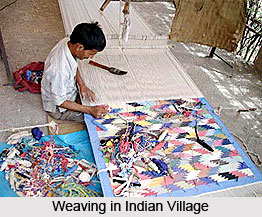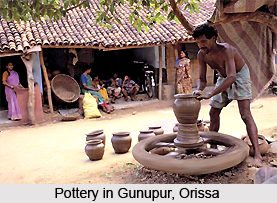Pottery of East India has gained national recognition since this craft received royal patronage during the age of cultural refinement. Eastern India has given birth to innumerable skilled potters who produce excellent clay and terracotta potteries with efficacy. West Bengal, Orissa, Bihar and Jharkhand are the various states of this part of India which specialise in the art of pottery crafting. Different techniques are utilized to bring alive the ancient tradition of this craft, which is the livelihood of thousands of people in Eastern India. Multiple forms of handicrafts are manufactured by the potters of these regions.
 Pottery of West Bengal
Pottery of West Bengal
West Bengal`s pottery art is as old as the Neolithic age. Regions of Bankura District, Birbhum District, Purulia District, Midnapore District, Asansol and the area of Kumartuli in Kolkata are renowned for their pottery products. Containers, vessels, plates for foods, figurines of deities, pots, pans, other items of domestic utility and household d‚cor are also produced by the potters of West Bengal. Clay idols of Goddess Durga and many other Hindu deities are crafted in Kumartuli, which boast of innovation. Some Bengali NRIs (non resident Indians) residing in US and England place orders for sculptures of Goddess Durga, which are transported to these remote places. Potters utilise the rich clay deposits found in the Bengal Rivers as the basic raw material for this work.
In Bishnupur, Chaurigacha and Katalia and some other places in Midnapore and Bankura, perhaps the most primitive method of hand-modelled pottery is still pursued, which are exclusively made by women. `Terracotta` or baked earth is also often employed to create unique pottery crafts. Black and red pottery is also common in West Bengal, which flourished during 1500 B.C. and continued developing in the 3rd century BC, as per historical records. Jars, vase-stands, tulip-shaped flower pots, basins, bowls and other utensils are a few of the red and black pottery products.
 Pottery of Orissa
Pottery of Orissa
Pottery craftsmen of Orissa create earthenware pots which are used frequently in several social and religious occasions. Geometrical, floral and fish motifs adorn most of the pottery artefacts of this Indian state. Simple clay and terracotta toys are also favoured. Such objects are generally manufactured by the tribals of Orissa. Plates, jars, cups, `khullars` and many other kitchen utensils are made with a special kind of clay. The items are highlighted with colours. Numerous containers are made with terracotta in Orissa.
Pottery of Bihar
Bihar produces unique clay pottery, which has been a rich tradition of this region since the Mauryan and Gupta period. Archaeological excavations at Rajgir and Nalanda have revealed the presence of craft in Bihar. Tiles and earthenware utensils are crafted by Bihar potters. Attractive paintings are done on the surface of the earthen pots in Bihar, particularly in Patna.
Pottery of Jharkhand
Skilled potters of Jharkhand make a range of products of domestic significance like earthen cups, flower vases, water jars and pots. Natives are fond of a huge pot which is meant for preparing `mahua liquor` and another local beer which is made from rice. Black coloured, gleaming pottery is also made in the region of Deogarh in Jharkhand.
Besides creating Hindu deities and utilitarian items since several generations, the craftsmen of Eastern India are also capable of crafting beautiful decorative artefacts. The potters of Eastern India, particularly of West Bengal, prefer working on a South Indian kind of wheel, seated on a high stool, which enables them to proceed with their work comfortably. Pottery art of this portion of the country is immensely popular not only in India, but also overseas.




















